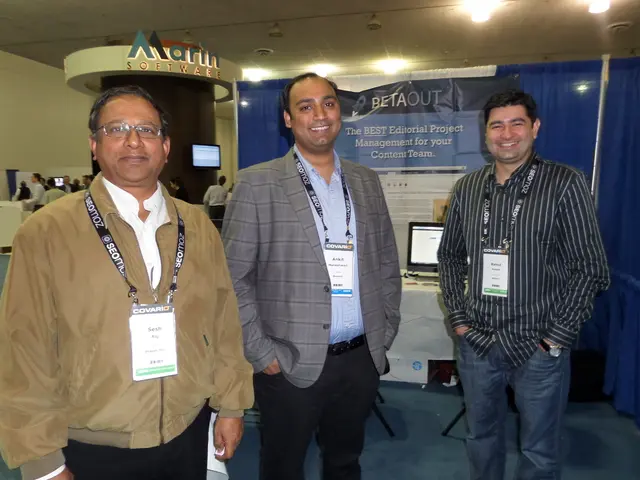Uncovering Insights on Digital Protection
In today's digitally interconnected world, safeguarding our online assets has become more critical than ever. The focus on cybersecurity has shifted towards advanced models, AI-driven tools, and proactive human-focused measures to combat the increasing threat of cyber attacks.
At the heart of this shift lies the Zero-Trust Architecture (ZTA), a security model that assumes no implicit trust for any user or device, whether inside or outside the network. By continuously verifying identities, enforcing least privilege access, using micro-segmentation to isolate systems, and preventing lateral movement of threats, ZTA provides a robust defence against expanding attack surfaces, especially in remote and hybrid work environments.
Human Risk Management and Security Awareness Training is another key strategy. With attackers increasingly leveraging AI-powered social engineering, organisations are emphasising training employees to recognise threats through behaviour-based learning, real-world phishing simulations, and adaptive security awareness programs. This reduces the likelihood of user compromise and strengthens the human element in security.
Comprehensive Risk Management is also fundamental. Identifying, evaluating, and mitigating risks is crucial, and security policies must be clearly formulated and communicated, with employees trained on best practices to handle organisational information safely. Cybersecurity strategies must align with broader organisational and digital transformation goals.
In terms of technology, Artificial Intelligence (AI) and Machine Learning (ML) are playing a significant role in enhancing cybersecurity. AI-powered threat intelligence enables real-time anomaly detection, automates threat responses, and strengthens defences against sophisticated attacks, including adversarial AI threats. AI tools also enable continuous monitoring and faster incident response.
Quantum-Resistant Cryptography is another essential technology as quantum computing advances. New cryptographic algorithms that can resist quantum attacks are becoming increasingly important for securing data and communications long-term.
Strong Encryption and Multifactor Authentication (MFA) are also crucial for securing new technologies and networks like 5G. Encryption protects data in transit, while MFA ensures that only authorised users and devices gain access.
Cloud and Edge Security Tools are vital in today's widespread cloud adoption and edge computing. Organisations use Cloud Access Security Brokers (CASBs), Cloud Security Posture Management (CSPM), and tailored edge security solutions to address risks from misconfigurations and decentralised data processing.
Network Monitoring and Micro-Segmentation are also vital for detecting potential threats in real time and limiting the spread of breaches.
Incorporating these strategies and technologies creates a robust cybersecurity posture designed to meet the challenges of increasingly sophisticated cyber threats in 2025 and beyond. Regular updates and patches, safe browsing practices, and the ability to detect and avoid phishing scams are crucial for everyone. A live cybersecurity policy framework, regular risk assessments, and cybersecurity education at all levels can further bolster defences.
In the digital world, cybersecurity operates on multiple layers of protection, including network security, application security, end-point protection, information security, and user-awareness training. Data encryption, blockchain technology, and AI are key technologies that make data unreadable to unauthorised users, offer secure, tamper-proof systems, and amplify cyber defences, respectively.
Cybersecurity is necessary for individuals, companies, and governments to protect against stolen or distorted data, disabled user end-points, disrupted operations, and exposed privacy. A defence-in-depth strategy, honeypots, and interactive application security testing (IAST) are among the tools used to increase the complexity for potential attackers and protect our digital landscape.
- The Zero-Trust Architecture (ZTA) is a security model central to today's cybersecurity shift, providing robust defence against expanding attack surfaces.
- In light of AI-powered social engineering, Human Risk Management and Security Awareness Training have become key strategies for strengthening the human element in security.
- Comprehensive Risk Management is fundamental, with security policies clearly formulated, communicated, and employees trained for handling organizational information safely.
- Artificial Intelligence (AI) and Machine Learning (ML) significantly enhance cybersecurity, strengthening defences against sophisticated attacks and enabling real-time anomaly detection.
- Quantum-Resistant Cryptography is essential as quantum computing advances, securing data and communications long-term with new cryptographic algorithms.
- Strong Encryption and Multifactor Authentication (MFA) are crucial for securing new technologies and networks like 5G.
- Cloud and Edge Security Tools are vital in today's widespread cloud adoption and edge computing, addressing risks from misconfigurations and decentralised data processing.
- Network Monitoring and Micro-Segmentation are essential for detecting potential threats in real time and limiting the spread of breaches.
- Deducing from the digital world, cybersecurity operates on multiple layers of protection, including network security, application security, end-point protection, information security, and user-awareness training, while data encryption, blockchain technology, and AI amplify cyber defences.




